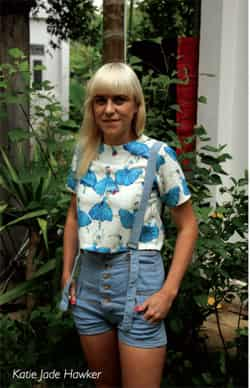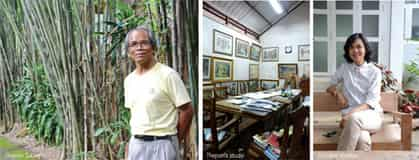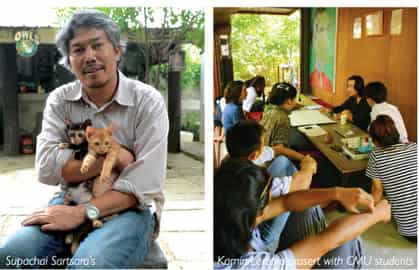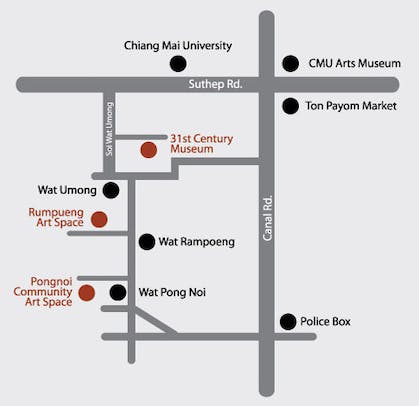If you drive west from Chiang Mai’s old city, down Suthep Road toward the cloud-capped, blue-green embrace of Doi Suthep, you will reach the back entrance of Chiang Mai University, recently ranked one of the top 100 universities in Asia. Across the street from campus, there are a series of numbered soi. Take any one down far enough and you’ll find a place where nature still flourishes. The air feels strangely yet perceptibly cooler the moment you turn away from the main road. Roadside noodle shops, blooming tamarind trees and serene forest temples line the cracked streets and it’s almost like you’ve travelled back in time, to the days before Chiang Mai was choked with traffic and tourism.
True, even here, traffic is increasing, with students zooming by on motorbikes and cars squeezing through lanes far too narrow to have been created at a time when cars existed. Land is being shorn and sheared for impending high rise apartments, and the old folks of the neighbourhood are already feeling wistful about days gone by. But something special has happened to this neighbourhood that sets it apart from others like it. A kind of movement has taken hold, calmly, quietly and under the radar. Indeed, this area, known as Wat Umong, has become one of the most densely packed communities of artists, art studios and galleries in all of Thailand. Who knew?

“The art scene in Chiang Mai has a tendency to be very closed,” says Katie Jade Hawker, 29, a British transplant and one of the few farang to fully break into the community. “But I think we all want to become more inclusive, to share our art with the people of Chia ng Mai and the rest of the world.”
Indeed, the goal of Katie’s non-profit, Surface Arts, is to facilitate connections between artists and the public. One of her newest projects is an artist residency programme at Rumpueng Loudspeaker Community Art Space, a nexus of collaborative creativity in the heart of the Wat Umong neighbourhood, and the first stop on my self-led art fieldtrip through the area.
Dotted with a hodgepodge of funky statuary, two kittens and a chicken coop, the gallery/studio/cafe is also owner Supachai Sartsara’s home, which he designed and built himself three years ago. A patchwork of white cement, large windows and sections of teakwood, the complex features an airy gallery space, several smaller studios, an open kitchen and two bedrooms furnished for visiting artists, who pay 30,000 baht a month to live, work and eat there. The most recently departed resident was a former Disney art director named Mark Rafter who used his time there to create an animation project about Thai street life.
“Our goal is to connect with the community more than we have before,” says Supachai, who has been living and working as an artist and teacher since he graduated from CMU two decades ago. His specialty is public art that addresses social, environmental and political issues, and he enjoys mixing performance with large-scale installations, such as an exhibition he once did at Tha Pae Gate that involved freezing flowers in blocks of ice and then smashing them with a hammer.
“Art is more than just looking at something beautiful; it makes beautiful things happen in your mind,” he tells me with a smile.

Into the Woods
Our next stop is the home of Thepsiri Suksopa, another famous Thai artist. He lives with his daughter, a professional shadow puppeteer, in a home that looks more like a personal jungle, complete with koi pond, bamboo grove and several old wooden buildings scattered throughout. One of these buildings is Thepsiri’s cavernous studio. We enter and find him sitting at a big teakwood table cluttered with books, papers, drawing utensils, postcards and a few odd masks.
Tanned and toned with tufts of grey hair, Thepsiri is 70 years old but strong as an ox and vibrant with energy. He tells us tales of his days as a travelling storyteller, which spanned decades, through times of war and student revolution. “My stories always included something interesting about war, peace, the environment or religion,” he says in Thai, a youthful sparkle in his eyes. “And all were true but the fairytales.”
Thepsiri arrived in Chiang Mai 40 years ago, back when there were “no artists, only forests.” His words take on a certain poignancy as they are nearly drowned out by the roar of a motorbike speeding past. Things have changed around here, he says, adding that he is currently drawing up plans for an art and environmental centre in Nan province, where he hopes to relocate within the next few years.
Today, Thepsiri is working on several books that incorporate both art and storytelling. He also dances (wearing one of the aforementioned masks and a long shiny wig, apparently) and partakes in what he calls “performance drawing.” He demonstrates by drawing my own portrait; the process features a series of rather violent gestures and takes about two minutes flat. With a final flourish, he unveils the final product, which resembles something out of Matisse’s sketchbook. “It doesn’t really look like you, but it’s fun!” he exclaims.
At the end of our visit, Thepsiri tells us we are welcome back anytime; he enjoys the company of students and other artists who come to visit regularly. “My gate is always open,” he says.
Fresh Forms
Chiang Mai has long been known as a hub for the arts, dating back to the temples, textiles and woodworking of the ancient Lanna years. But right now, Chiang Mai’s art scene is in the midst of a contemporary growth spurt, one that is trying to break away from the traditions of the past in order to find relevance in the new, digital age.
“Before, contemporary Thai art was pretty much ignored on the international stage, but recently there’s been a turnaround,” says Katie. “The last global trend was Latin America; now art critics are focusing on Southeast Asia.”
While there is a growing push for creativity that can be seen in the city’s recent efforts to apply for the UNESCO Creative City designation, and with money being pumped into the economy in preparation for ASEAN, it’s still not easy for artists here to eke out a living. The focus of the various governmental ministries and tourism industry remains historical, and this near-obsession with the past seems to have a limiting effect on the present.
“When it comes to traditional methods of art, Thailand is very behind the rest of the world,” notes Katie. “I think it’s because here, people take traditions more seriously than they do in the west. They pay homage to the past rather than ripping it up and creating something new.”
That said, nearly all the young artists I spoke with seemed more interested in new media than traditional art forms. The temporary Rumpueng Loudspeaker exhibition I saw featured a variety of sound installations and interactive art pieces meant to blur the line between artist and observer.
“These new forms are very freeing,” adds Katie. “Perhaps because there’s no background, no history, no need to acknowledge the past. Thai artists can make them their own because they have a blank slate on which to come up with new and outrageous ideas.”
University Ties
Nearly everyone I spoke to credits the emergence of Wat Umong’s art scene to its proximity to CMU. Most of the fledgling artists here are either students or recent alumni, and many of the more established figures still teach there (and/or were students themselves).
Morakot Ketklao is one of these professors/artists. Her goal is not only to teach her students about art, but also to share with them the benefits of integrating art into real life.
“Art can often be something that is done alone, shut up in a studio,” says Morakot. “I would like my students to touch more life, to see beyond themselves, to do more group projects, and to make art less individual and more communal.”
In this vein, Morakot recently organised the latest edition of what she calls “World Cafe Seminar,” a day of communication and critique between CMU art students and local artists, which will culminate in an “art crawl” of public installations all along Soi Wat Umong.

Power to the People
The seminar took place on a warm afternoon at the 31st Century Gallery, the brainchild of acclaimed artist Kamin Lertchaiprasert, who resides in his live-in studio next door. The sunlight filters through the tamarind trees, casting a dappled light onto a series of corrugated tin buildings made from recycled shipping containers. The gallery inside is based on Kamin’s idea that “our body is a museum; our spirit is art,” and features an eclectic collection of pieces handpicked for their ability to tell a meaningful story.
In one glass display case sits a pillowcase and a series of flowers embroidered out of human hair, which seems slightly disturbing until you read the sweet story posted up on the wall beside it, about a devoted daughter who honoured her dying father’s wish to keep his hair as a memorial of his love, since he had no property to pass down. On the wall opposite hangs a series of wood prints made by a group of young Indonesian artists to expose issues in their impoverished community.
It’s an inspiring place for these young people to gather, one that opens up for free interpretation the very definition of art. There is a buzz in the air as the artists and students – a motley crew in torn jeans and valiant attempts at facial hair – huddle in small groups, discussing ideas for the collaborative pieces they will create for the upcoming art crawl.
“It’s art for the people,” says Atong, a 20-year-old student. “It’s fun. We’re taking the art out of the classroom and into the community.” His fellow group members nod in agreement before returning to their word web brainstorming activity.
“I think students receive a bit of a shock when they get into art school in Thailand,” says Katie, who has worked with CMU students often during her time in Chiang Mai. “Suddenly, no one’s telling you what to do, so you have to think for yourself and make your own opinions. Usually, Thai students are told never to question the teacher. In art school, you have to question everything! That’s the nature of art.”

Arty Parties
My last stop is Pongnoi Community Art Space, another small gallery hidden on a soi near Wat Pongnoi. Like Rumpueng, Pongnoi has become a hub for young artists to gather and socialise, as well as a showcase for some of the most interesting contemporary art in Thailand today. The gallery currently houses Bangkok-based artist Karin Phisoyabut’s zen-like ceramics exhibition, a series of lovely sculpted figures housed in glass bell jars and polygonal terrariums lined with living plants.
Exhibition openings here, as at Rumpueng, are spirited affairs, often consisting of live bands and avant-garde performance art. However, it’s hard to catch wind of such events unless you’ve got a direct connection.
This is another one of the things Katie hopes to change, in her efforts to open up the arts community to a wider audience. One of her newest projects is a monthly “art party” called Sub-Station, which will take place at Sangdee Gallery.
“Our goal is to build a new audience for experimental live art,” says Katie. “We want to give artists a public platform to present something new, and to receive feedback. At the same time, we want to provide the audience with a fun, relaxed environment to experience art without fear. It’s our chance to make public something that is usually more hidden away.”
One of the featured players at the first Sub-Station party was Boonsong Rodthab, a young Chiang Mai performance artist with a bear-like stature, long hair and an impressive beard. Boonsong is excited about the emergent artscape of Wat Umong, and the ripple effect that it seems to be having on the rest of the city.
“Here, the community supports the artists, and the artists support the community,” he says. “The art is fresh, incomplete. There’s space for new artists, and everyone is welcome to join the discussion.”

Rumpueng Loudspeaker: www.rumpuengartspace.wordpress.com
31st Century: www.31century.org
Pongnoi: www.facebook.com/pages/Pongnoi-Community-Art-Space/222829674503486
Surface Arts: www.surfacearts.co.uk
